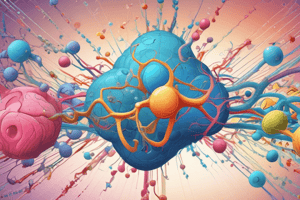Podcast
Questions and Answers
What is the role of the α subunit of a G protein in signal transduction?
What is the role of the α subunit of a G protein in signal transduction?
- The α subunit splits GTP into GDP and Pi, acting as a switch. (correct)
- The α subunit binds to the receptor and activates the effector enzyme.
- The α subunit has no role in signal transduction.
- The α subunit inhibits the effector enzyme.
Which of the two most common effector enzymes for G protein-coupled receptors is responsible for the production of the second messenger cyclic AMP (cAMP)?
Which of the two most common effector enzymes for G protein-coupled receptors is responsible for the production of the second messenger cyclic AMP (cAMP)?
- Phospholipase C
- Protein kinase A
- Ion channels
- Adenylyl cyclase (correct)
What is the role of inositol trisphosphate (IP3) as a second messenger?
What is the role of inositol trisphosphate (IP3) as a second messenger?
- It enters the cytoplasm and binds to a calcium channel on the endoplasmic reticulum, causing the release of calcium into the cytosol (correct)
- It remains in the lipid portion of the membrane and interacts with protein kinase C
- It binds to and activates protein kinase C
- It activates adenylyl cyclase to produce cAMP
What is the role of cyclic AMP (cAMP) in the cAMP signaling pathway?
What is the role of cyclic AMP (cAMP) in the cAMP signaling pathway?
Which of the following is a function of calcium as a second messenger?
Which of the following is a function of calcium as a second messenger?
What is the role of the G protein-coupled adenylyl cyclase-cAMP system?
What is the role of the G protein-coupled adenylyl cyclase-cAMP system?
Which of the following is not a step in the general sequence of events in the cAMP signaling pathway?
Which of the following is not a step in the general sequence of events in the cAMP signaling pathway?
What is the mechanism of activation of the phospholipase C pathway?
What is the mechanism of activation of the phospholipase C pathway?
What is the second most common effector enzyme for G protein-coupled receptors?
What is the second most common effector enzyme for G protein-coupled receptors?
What are the two types of intracellular (nuclear) receptors described in the text?
What are the two types of intracellular (nuclear) receptors described in the text?
What are the two main second messengers produced by the activation of phospholipase C in the phosphoinositide signaling pathway?
What are the two main second messengers produced by the activation of phospholipase C in the phosphoinositide signaling pathway?
Which of the following is a key step in the G protein-coupled receptor signaling pathway?
Which of the following is a key step in the G protein-coupled receptor signaling pathway?
What is the primary function of phospholipase C in cell signaling?
What is the primary function of phospholipase C in cell signaling?
Which of the following is a second messenger produced by the activation of phospholipase C?
Which of the following is a second messenger produced by the activation of phospholipase C?
What is the primary function of protein kinases in cell signaling pathways?
What is the primary function of protein kinases in cell signaling pathways?
Which of the following receptors is known to activate the phospholipase C signaling pathway?
Which of the following receptors is known to activate the phospholipase C signaling pathway?
What is the primary mechanism for terminating the signal initiated by the adenylyl cyclase-cAMP pathway?
What is the primary mechanism for terminating the signal initiated by the adenylyl cyclase-cAMP pathway?
Flashcards are hidden until you start studying
Study Notes
- Inactive receptors can be found in the cell nucleus and are activated by ligands like thyroid receptors, leading to altered gene transcription rates.
- Receptor activity can be terminated by removing chemical messengers, degrading them, or endocytosis of the receptor-ligand complex.
- Second messengers like cAMP, calcium, and effector proteins play crucial roles in signal transduction pathways.
- G-protein-coupled receptors can activate ion channels or enzymes in the plasma membrane, with examples like muscarinic ACh receptors requiring G-proteins for action.
- Adenylyl cyclase is an important enzyme in the cAMP pathway, converting ATP to cAMP, which then activates protein kinase A (PKA) to phosphorylate other proteins in the signal cascade.
Studying That Suits You
Use AI to generate personalized quizzes and flashcards to suit your learning preferences.




